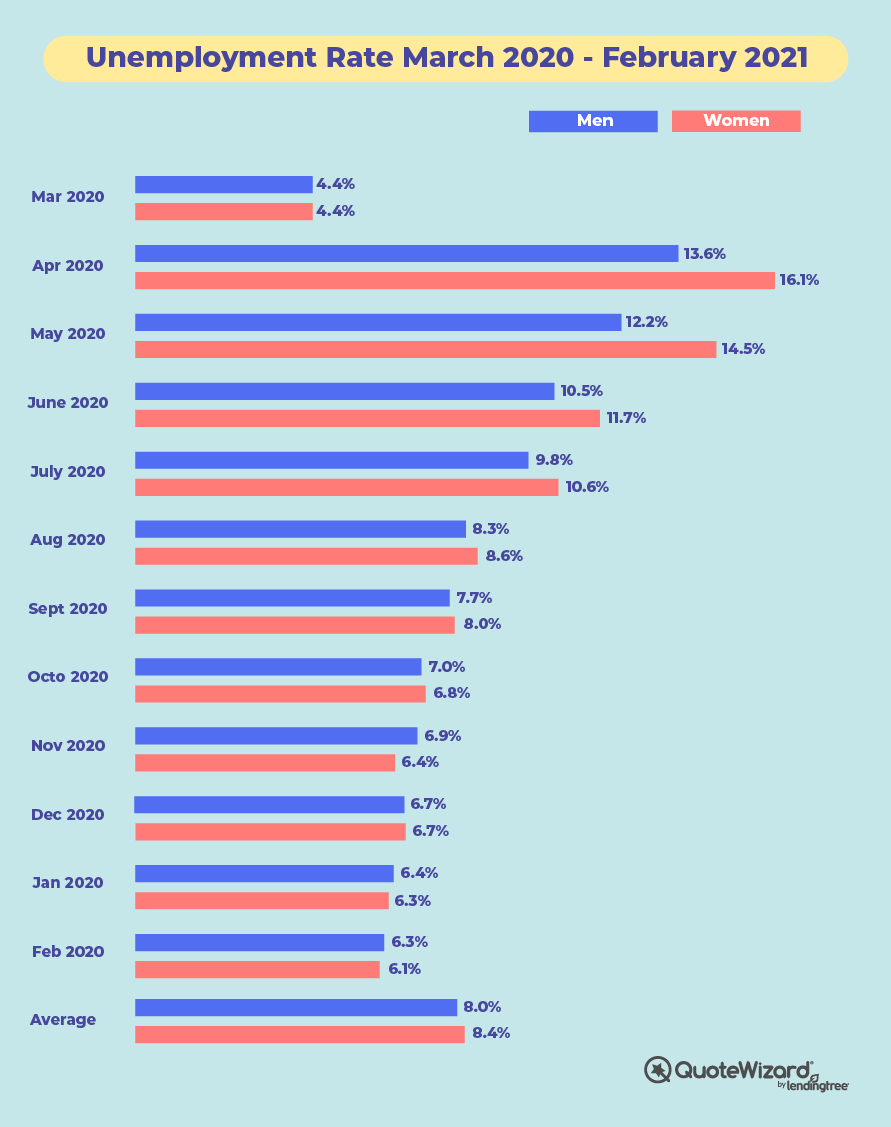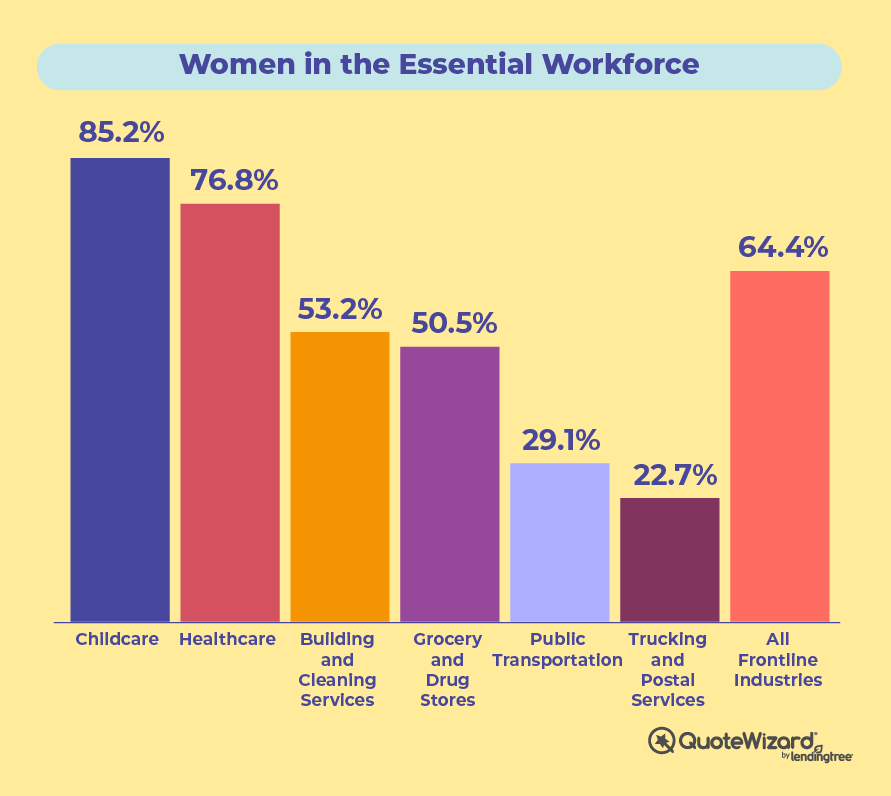As we move into the second year of the COVID-19 pandemic, our team of analysts took an in-depth look at its impact on women. In unemployment reports, health surveys and on the frontlines, a consistent pattern emerged: Women — especially women of color — have disproportionately borne a great share of the pandemic’s toll.
Key findings:
- The unemployment rate for women was consistently higher than that for men throughout most of 2020, reaching up to 16% in April.
- Women had 51.7% of the share of unemployment claims. In Vermont, that number reached 66.7%.
- Thirty-three percent of women did not work due to COVID-19-related child care issues compared to 10.2% of men.
- Nationally, 43.7% of women delayed or had no access to health care compared to 36.8% of men.
- The rate of COVID-19 cases per 100K since November 2020 was 205.7, compared to 177.8 for men.
- Women consisted of 64.4% of all frontline workers during the pandemic. Women make up 76.8% of health care workers.
- According to the Bureau of Labor Statistics, women make nearly 20% less than men. In real dollars, that's roughly $195 a week or $10,157 a year less.
Opportunities lost
The first wave of job losses started shortly after lockdowns began. In March 2020, the unemployment rate for women was 4.4%. By April, it was over 16%. And while men also saw a dramatic increase in unemployment, the unemployment rate for women was consistently higher throughout most of 2020.

The unemployment gap between men and women is even more stark when broken down across state and demographic lines. According to the most recent statistics available, women represented more than 55% of unemployment insurance (UI) claims in 12 states.
| Rank | State | % UI claims |
|---|---|---|
| 1 | Vermont | 66.7% |
| 2 | Rhode Island | 58.9% |
| 3 | Mississippi | 57.8% |
| 4 | Alabama | 57.1% |
| 5 | Connecticut | 57.0% |
| 6 | Maryland | 57.0% |
| 7 | New Hampshire | 55.9% |
| 8 | New Jersey | 55.8% |
| 9 | Virginia | 55.5% |
| 10 | Maine | 55.2% |
| 11 | Montana | 55.1% |
| 12 | Pennsylvania | 54.5% |
| 13 | Delaware | 54.4% |
| 14 | Hawaii | 54.3% |
| 15 | South Carolina | 54.3% |
| 16 | Massachusetts | 54.1% |
| 17 | Missouri | 54.0% |
| 18 | Louisiana | 53.9% |
| 19 | Tennessee | 53.9% |
| 20 | North Carolina | 53.9% |
| 21 | Illinois | 53.7% |
| 22 | Michigan | 53.5% |
| 23 | Minnesota | 53.4% |
| 24 | Kentucky | 53.1% |
| 25 | Georgia | 53.0% |
| 26 | Florida | 52.8% |
| 27 | California | 52.7% |
| 28 | Arkansas | 52.6% |
| 29 | Iowa | 52.6% |
| 30 | Indiana | 51.9% |
| 31 | Wisconsin | 51.6% |
| 32 | Oregon | 51.6% |
| 33 | Idaho | 51.4% |
| 34 | New York | 50.9% |
| 35 | Nebraska | 50.7% |
| 36 | Alaska | 50.5% |
| 37 | South Dakota | 50.4% |
| 38 | Arizona | 50.4% |
| 39 | Washington | 50.2% |
| 40 | New Mexico | 49.9% |
| 41 | Colorado | 49.8% |
| 42 | Ohio | 49.6% |
| 43 | Kansas | 48.8% |
| 44 | Nevada | 47.9% |
| 45 | West Virginia | 47.7% |
| 46 | Utah | 47.4% |
| 47 | Texas | 47.3% |
| 48 | Oklahoma | 46.7% |
| 49 | North Dakota | 39.1% |
| 50 | Wyoming | 33.4% |
| -- | U.S. Total | 51.7% |
Jobs and women of color
Broad statistics mask the pandemic’s impact on women of color. We found that women who identify as Black or African American, Hispanic or Latino, or Asian had an unemployment rate several points higher than men as a whole.
| Ethnicity | February 2020 unemployment rate | February 2021 unemployment rate |
|---|---|---|
| Black or African-American women | 4.9% | 9.9% |
| Hispanic or Latino women | 4.9% | 8.5% |
| Asian women | 3.0% | 7.9% |
| Men as a whole | 3.2% | 6.2% |
The tables above tell only half the story, though. According to the National Women’s Law Center, more than 5.3 million women have left the workforce since February 2020. This means only 57% of women are working, the lowest number since 1988.
Jobs and Childcare
Child care is one reason large numbers of women left the workforce. By analyzing Census Bureau Pulse Surveys, we found women were three times more likely to not be working because of child care.
| Men | Women |
|---|---|
| 10.2% | 33.0% |
Health care toll
The coronavirus’ impact on women’s health goes far beyond the number of COVID-19 cases. Throughout the pandemic, we found women reported higher levels of depression and anxiety, while also having less access to health care.
| Indicator | Men | Women |
|---|---|---|
| % of people experiencing anxiety or depression | 34.0% | 42.0% |
| % of people with delayed or no access to health care | 36.8% | 43.7% |
| COVID-19 cases per 100K (since November 2020) | 177.8 | 205.7 |
Frontline essentials
From nurses and child care providers to grocery store clerks and pharmacy technicians, women make up a majority (in some cases a vast majority) of essential workers.

Despite their proportionally larger role in the essential workforce, women are being paid less. According to the Bureau of Labor Statistics, women make nearly 20% less than men. In real dollars, that's roughly $195 a week, or $10,157 a year, less.
For many women, the issues highlighted above sound all too familiar. For too long, women have struggled with unequal representation, unequal pay and unequal opportunity, the ongoing pandemic only accelerated and exposed those issues even more. Women of color, especially, have lost more jobs and struggled to find health care while also working on the frontlines of this dangerous disease.
Nearly 77% of all health care workers are women. Nationwide, 27 million women are frontline or essential workers — that’s 64% of all workers. The burden of the COVID-19 outbreak has not been felt equally. We must keep this in mind if we want to truly recover. Because the issues many women faced before the pandemic have only become more dire to address.
Methodology:
QuoteWizard’s team of analysts evaluated eight data sets to represent the unequal toll the coronavirus pandemic has taken on women compared to men.
The first source on the unemployment rate was compiled from the U.S. Bureau of Labor Statistics from March 2020 to February 2021. It represents the unemployment gap between women and men month to month throughout the pandemic.
The second source includes women’s share of state unemployment insurance claims compiled from the Institute for Women's Policy Research. This dataset offered insight into the percentage of unemployment insurance claims as a relative rate compared to men in September 2020.
The third source we evaluated was the National Women’s Law Center, which provided an analysis for the number of Asian women currently unemployed compared to February 2020.
Fourth, we analyzed the U.S. Census to find the percentage of people not working due to COVID-19-related child care issues (summer 2020).
The fifth table we analyzed was the National Center for Health Statistics (NCHS) and Census Bureau Household Pulse Survey on COVID-19’s Impact on Women’s Health. This dataset was segmented into three categories, anxiety and depression, reduced access to health care and COVID-19 case rates.
The pie chart on frontline workers was sourced from the Center for Economic and Policy Research. This depicts the percentage of women in various frontline worker industries compared to men.
References:
QuoteWizard.com LLC has made every effort to ensure that the information on this site is correct, but we cannot guarantee that it is free of inaccuracies, errors, or omissions. All content and services provided on or through this site are provided "as is" and "as available" for use. QuoteWizard.com LLC makes no representations or warranties of any kind, express or implied, as to the operation of this site or to the information, content, materials, or products included on this site. You expressly agree that your use of this site is at your sole risk.